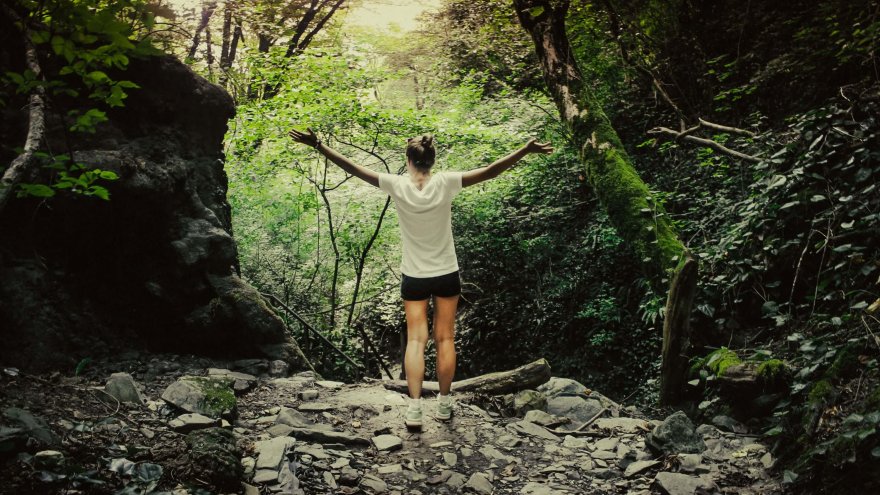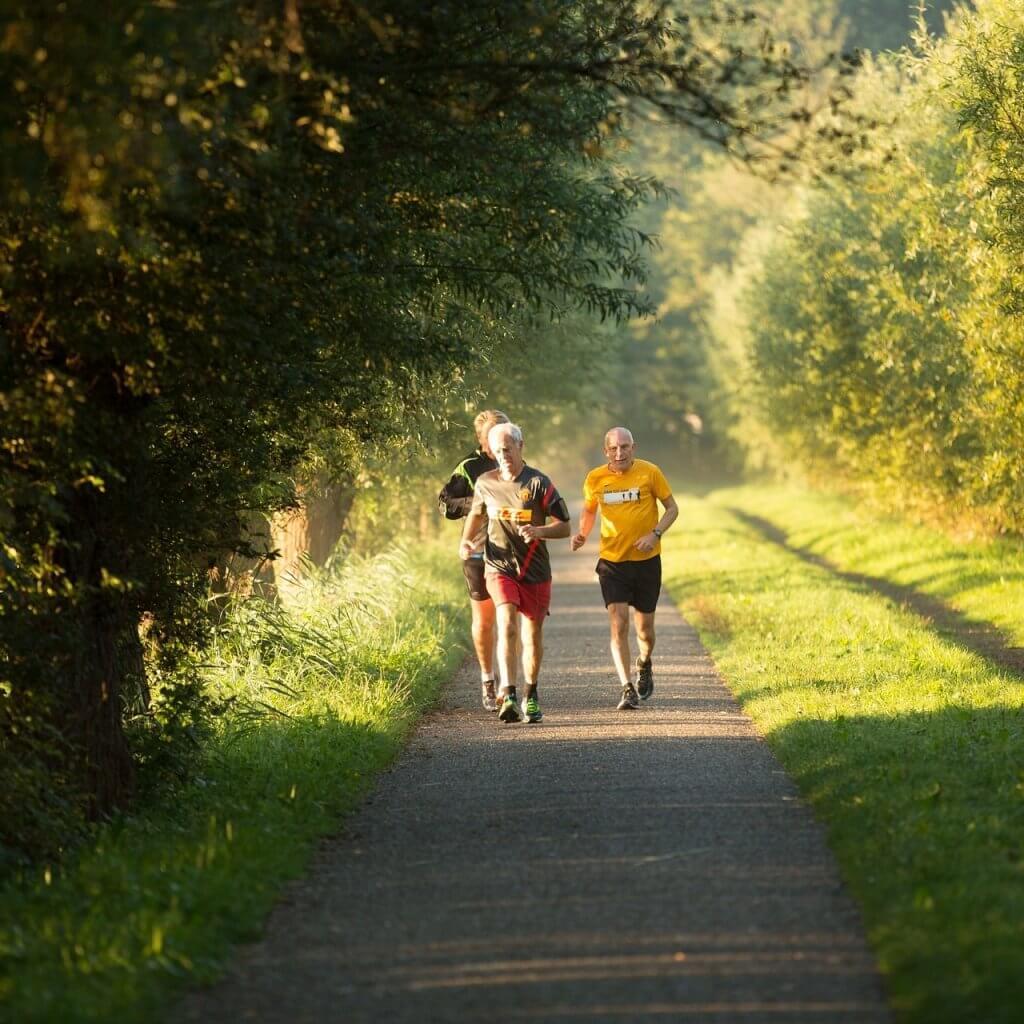Additional Benefits of Training in Nature

Running offers a myriad of different health benefits. Struggling with anxiety and depression? Then lace up and head out. Want to boost brain function? Then get up and run. And that’s in addition to the more commonly known benefits of running, like assisting with weight management and boosting self-confidence. But did you know that running in nature offers some extra benefits when compared to plodding the pavement or hitting the treadmill? Yip, it’s true. By running on the wild side you’re putting yourself in line for some incredible add-ons. So let’s have a look at what you’re in for!

Trail running may improve mental well-being
Runnerclick has previously reported on the positive impacts of running on mental issues like depression and anxiety. And while these impacts are life-changing for many individuals suffering from mental issues, the good news doesn’t stop there.
A 2015 study by a team from Stanford University concluded that trail running, in particular, decreased worry, anxiety and other negative thoughts in study participants. The study specifically focused on the effect of exercising in nature on rumination. (Rumination is a relentless cycle of negative thoughts and anxiousness that increases the risk of depression and mental illness.) It was found that study participants who exercised in nature not only reported a decrease in rumination, but functional MRI scans (fMRI scans) of their brains also indicated a decrease in neural activity in the part of the brain that is associated with mental illness. In contrast, neither of these perks were noted in study participants who exercised in an urban setting.

The exact mechanism(s) through which these impacts take place are still uncertain. It is, however, believed that natural settings make us feel less threatened, thereby switching off a deeply-rooted stress response.
These findings are in line with that of a 2012 study by a team from the University of Glasgow. The latter study found that exercise in a natural outdoor environment lead to a lower risk of poor mental health. In fact, the results of the study indicate that individuals who exercise outdoors can expect a 50% bigger (positive) impact on mental health than those who train indoors.
Running in nature may boost self-esteem
A team from the University of Essex found in 2010 that even as little as 5 minutes of exercise in nature can boost both mood and self-esteem. This study looked at data gathered from 1 252 individuals of different ages, genders and mental health backgrounds. It was concluded that “green exercise” boosted the self-esteem of persons from all ages and social groups. Young people and the mentally ill did, however, show the greatest improvement.

And if you’re scared that you’ll miss out because you’re located far from the sticks, don’t worry. This study also found that parks located within towns or cities are also beneficial. Parks with a stream or water feature appeared to have the biggest benefits. So set off on a mission to find your nearest neighborhood park now!
Running outdoors may lead to improved exercise consistency in post-menopausal women

A team of Canadian researchers found in a 2015 study that post-menopausal benefit more from outdoor exercise than indoor exercise. In addition, heading outdoors increased their ability to stick with an exercise regime. This 12-week study concluded that outdoor exercise leads to a decrease in depression symptoms and a general increase in physical activity in post-menopausal women.
Outdoor exercise may cause older individuals to exercise longer and more often
A 2012 study found that both men and women above the age of 65 who exercised outside were significantly more active than seniors who trained indoors. Study participants who headed outdoors added an average of 30 minutes or more of physical activity to their routines per week, although overall self-assessments of health were unaffected.

Green exercise may alter your perception of effort
A 2013 study published in Extreme Physiology & Medicine states that participation in ‘green exercise’ may have an impact on the perception of effort. Individuals who work out in nature have been found to achieve greater exercise intensity without a change in the perception of effort. In other words, a tough workout may feel easier when done in nature. Which, in turn, may lead to increased motivation and consistency.
The perception of effort is an extremely complex process, with various different receptors within the human body providing information to the brain. It is believed that, in the case of ‘green exercise’, the input from the visual system may act as a distractive stimulus. In other words, paying attention to an aesthetically pleasing, green environment may reduce the awareness of physiological effort and strain, as well as associated negative emotions.
So do you want to keep going stronger for longer? Turn to Mother Nature!
Read also about best vegan running shoes.
The takeaway
If you want to take the benefits that you’re already reaping from running to the next level, look no further than your nearest park or trail. Sure, it might be easier to plod the pavement or hop on the treadmill, but there’s no denying the additional benefits of going green. Not only will hitting the trails challenge your body in a whole new way while being gentle on the joints, but it will also reward you with a host of extra perks.
Just remember to be safe. Buddy up or let someone know where you’re going, and be sure to carry your phone just in case.
Sources
- , Feeling anxious? Research shows trail running benefits your brain, Online publication
- , Nature experience reduces rumination and subgenual prefrontal cortex activation, Scientific journal
- , Five minutes in the green may boost self-esteem, Online publication
- , What is the best dose of nature and green exercise for improving mental health? A multi-study analysis., Scientific journal
- , Adherence to exercise and affective responses: Comparison between outdoor and indoor training, Scientific journal
- , The benefits of exercising outdoors, Online publication
- , Outdoor physical activity and self-rated health in older adults living in two regions of the US, Scientific journal
- , The great outdoors: How a green exercise environment can benefit all, Scientific journal
- , Jogging in forest twice as good as trip to gym for mental health, Online publication
Latest Articles
 Is Running on a Treadmill Easier Than Running Outside?Runners have their own preferences, whether it is treadmill running, running outside on the road, or exploring trails. So...
Is Running on a Treadmill Easier Than Running Outside?Runners have their own preferences, whether it is treadmill running, running outside on the road, or exploring trails. So... Is It OK to Use Trail Running Shoes on the Road?While trail running shoes can be used on roads, especially in situations where a runner encounters mixed terrains or pref...
Is It OK to Use Trail Running Shoes on the Road?While trail running shoes can be used on roads, especially in situations where a runner encounters mixed terrains or pref... How to Fix Sore Quads After Running?Rest, ice, gentle stretching, and over-the-counter pain relievers can help soothe sore quads after running. Also, ensure ...
How to Fix Sore Quads After Running?Rest, ice, gentle stretching, and over-the-counter pain relievers can help soothe sore quads after running. Also, ensure ... 10 Fruits With The Most Electrolytes to Replace Sports DrinksThese fruits are high in electrolytes such as potassium, magnesium, and calcium, essential for hydration, muscle function...
10 Fruits With The Most Electrolytes to Replace Sports DrinksThese fruits are high in electrolytes such as potassium, magnesium, and calcium, essential for hydration, muscle function...

